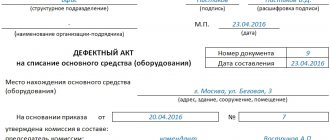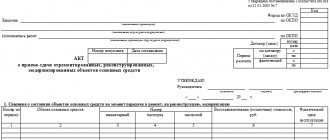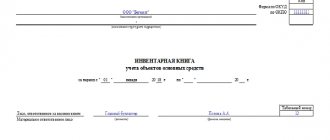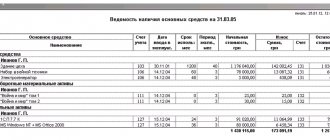Using the unified form OS-4, an act on the write-off of a fixed asset item is filled out. You can not use the official form of the OS-4 act, but independently develop forms of primary accounting documents, including for registering the liquidation of a fixed asset. A document that confirms the liquidation of a fixed asset can be, for example, an act of write-off (liquidation) of a fixed asset item. You can develop the document yourself; to fill it out, take the unified OS-4 form as a sample. The form was approved by Resolution of the State Statistics Committee dated January 21, 2003 No. 7.
The decision to liquidate fixed assets must be formalized by order of the manager. Data on the disposal of fixed assets must also be included in the documents that are drawn up by the company to record the presence and movement of fixed assets (for example, you can use an inventory card for recording a fixed asset item in Form No. OS-6). It is worth paying attention that the registration of liquidation of vehicles must be carried out differently, in a special order.
Form of the act
To draw up the act, the unified form OS-4 is used. The form is filled out and executed when writing off fixed assets that have become unusable and there is no way to continue using them.
However, this form is not used for all operating systems. For example, if we are talking about fixed assets that relate to road transport, the OS-4a form is used. The need to draw up a different form is explained by the fact that when decommissioning a vehicle, it is necessary to indicate many additional characteristics, for example, mileage data, serial numbers of parts and documents, information about deregistration.
In addition, there is also the OS-4b form. It is used when several fixed assets are subject to write-off at once.
The procedure for writing off fixed assets
The write-off process must be reflected in the financial statements. This is recorded in income and expenses. Accounting not only records the disposal of property, but also indicates additional information:
- residual value of the object;
- wear and tear cost;
- the amount of profit upon the possible sale of property.
As a rule, debiting begins with the opening of account 01. Additionally, a subaccount is opened for it.
It is worth remembering that if property is moved between the structures of one company, this cannot be considered a disposal. Also, property that has undergone reconstruction or installation of auxiliary equipment is not subject to write-off.
conclusions
Resolution of the State Statistics Committee No. 7, January 21, 2003 a unified certificate form OS-4b was approved.
Compilation of this form is necessary for writing off a group of similar assets for the purpose of their subsequent disposal or sale.
The commission is engaged in documenting and finalizing the OS-4b act.
Filling can be done in a clearly unified form or independently in any form.
The article describes typical situations. To solve your problem, write to our consultant or call for free:
Moscow - CALL
+7 St. Petersburg — CALL
+7 Other regions - CALL
It's fast and free!
How to correctly draw up an act of write-off of fixed assets
Since sooner or later an enterprise has to make a write-off, every accountant must be able to correctly formalize this procedure. This allows the company to always display the real situation with the property on the company’s balance sheet.
Various objects are subject to write-off:
- faulty transport;
- dilapidated buildings;
- outdated equipment;
- other property.
The main reason for write-off is the unsuitability of the property. The main condition is that it cannot be repaired or restored. This is determined by a specially created commission. However, if we are talking about technically complex property, it is unlikely that it will be possible to do without an expert opinion. For example, the air conditioner broke down. Company employees visually see only non-working equipment. An opinion on its malfunction can only be given by a specialist provided by the relevant company.
( Video : “Write-off of fixed assets - accounting”)
Even if the faulty equipment can be repaired, the service company must provide a full estimate to fix the problem. This will allow you to determine the economic benefit of the repair. If repair is not practical, the equipment is subject to write-off. Thus, it is the expert’s opinion that allows you to determine whether faulty OS can be written off.
Inventory
In order to establish the safety of property, organizations conduct an inventory. The procedure for its implementation is regulated by the Methodological Instructions approved by Order of the Ministry of Finance No. 49 of June 13, 1995.
Inventory is also necessary to identify fixed assets that are unsuitable for use, or whose further use in the company’s activities is impractical. A sample order for an inventory of fixed assets can be downloaded at the end of the article.
Conducting an inspection can be mandatory and proactive. Inventory is required in the following cases (clause 1.5 of the Guidelines):
- preparation of annual reports (an inventory of fixed assets is allowed once every three years);
- change of financially responsible person;
- identification of facts of damage and theft of property;
- natural Disasters.
To carry out the inventory, the company's management appoints a commission. It is advisable to include representatives of the administration, employees of engineering and technical services, and financial employees. The inspection is carried out in the presence of the person responsible for the safety of the property.
If obsolete or damaged equipment is identified, the commission may decide to repair, restore the OS, or liquidate it.
Sample order for inventory of fixed assets
Instructions for filling out an act for write-off of fixed assets
The form has three sections. Each of them is designed to display specific information. An accounting employee is responsible for filling out the document. This can also be done by an employee who is responsible for the safety of fixed assets. In addition, a special commission is created that is directly involved in drawing up the act. Filling is carried out in four stages:
- Title page . Designed to indicate the company name. If the property belongs to a specific department or division, it is also indicated. The write-off is carried out on the basis of an order, therefore the date of its preparation and number are indicated on the title page. The date of direct write-off of the property is also indicated. Here you can see a column intended to indicate the reason for the write-off. This may be wear and tear, inappropriate repair, or physical aging.
- First table . Information and characteristics of the OS are entered here. The name of the product being written off, its serial and inventory numbers, the date of issue and registration with the organization must be indicated here. The relevant columns indicate the actual service life of the object, its initial cost and wear and tear costs.
- Second table . Additional data about the means is indicated here, for example, the materials that make up the OS. This table is filled out by members of the commission, confirming that the property is truly unsuitable for further use. The commission also gives its conclusion and detailed reason for the write-off. Each participant signs the document.
- Third table . Filled out by an accounting employee who calculates finances associated with the property being written off. If dismantling the OS required monetary costs, this must also be indicated in the document.
The document is completed in two copies. One of them remains with the employee who was financially responsible for this object. The second copy is transferred to the accounting department, where the official write-off is carried out.
Filling out OS-4b
The form has a front and back side. Both must be filled out.
Front side of OS-4b
When filling out the header, you must indicate: the name of the organization, the name of the structural unit, OKUD and OKPO, the date when the object was written off from accounting, the full name and personnel number of the responsible person.
Next, note the number and date of preparation of the document to be filled out. Nearby there are fields for approval by the manager of the write-off. They are filled in at the very end.
Then the main part begins - on the front page it consists of a table with information about the state of OS objects. What you need to indicate in columns 1 to 8:
- Record number in order. Only one row in the table should be allocated for each object.
- OS object name.
- Inventory number.
- The actual operating life of the OS object.
- Initial or replacement cost.
- The amount of accrued depreciation.
- Residual value. It is calculated by finding the difference between the indicators in columns 5 and 6.
- Reason for write-off. This could be a breakdown, moral or physical wear and tear, or theft.
If the OS object contains precious metals, then fill out columns 9 to 13: indicate the name, item number, units of measurement, quantity and weight of raw materials.
Reverse side of OS-4b
Here the commission that conducted the inspection must write a conclusion. The chairman and members of the commission must sign, confirming the accuracy of the specified data.
Then there is a table with information about what material assets the company received from the write-off of fixed assets. This part is filled out in the accounting department. You must enter the following information:
- A document on the sale of valuables remaining from the OS object and its details.
- Name, item number, unit of measurement, quantity, cost of materiel.
- Correspondence of accounts.
- Serial number in the materials accounting card according to form M-17.
At the end of the table, the cost of all materiel values is summed up. Then indicate the results of the write-off, and write in words the amount of proceeds from the sale.
After this, the document is signed by the chief accountant and approved by the manager.
Is it possible not to draw up an act?
When an object or equipment registered with an enterprise is written off, a corresponding mark is made on the inventory card. This is what the company's accounting department does. However, the basis for performing this procedure is the executed act of write-off of the fixed assets. It is also necessary for accounting purposes aimed at write-offs. Thus, without drawing up an act, it will not be possible to officially write off the property on the balance sheet of the enterprise.
Like other valid documents, the write-off act must be kept in the accounting department. After the expiration date, the document is sent to the organization’s archive for storage. He has been here for at least three years. There may also be a longer storage of the act, if this is provided for by the standards established by the organization.
When drawing up the act, try to avoid questionable wording of the reason for the write-off. The commission's conclusion should not raise additional questions for the inspection authorities. There are often situations when an accountant is accused of illegally writing off property, which may result in a fine. However, this employee only displays the write-off of the fixed assets in accounting. Although the accountant’s responsibilities do not include checking the commission’s conclusion and the grounds for write-off, it is still recommended to do so. The accountant must ensure that the commission's decision is as convincing as possible.
Who does it?
In order to establish that a certain group of fixed assets have become unusable, a commission is created.
It is this commission that is responsible for documenting and finalizing the OS-4b act.
After the form is filled out and endorsed by all members of the write-off commission, the act is sent to the manager for signature. Without the consent of the manager, the document will be considered invalid, so his participation is mandatory for this procedure.
In addition to drawing up the act, a procedure for drawing up an order on the need to write off a group of fixed assets is also necessary. Based on this document, the commission carries out its professional activities.
The commission includes at least 3 people. A prerequisite for them will be work at this enterprise and an official position confirmed by an employment contract.
However, there are cases when a person who has knowledge in this area or has a suitable education can become a member of the commission. This candidacy is approved by the head of the organization.
How is the unified form OS-4b filled out?
The unified form OS-4b is not mandatory for use.
A similar document can be developed independently in the organization.
You can also supplement the already established form with those details that the company considers necessary.
It is easy to draw up the document, as there are section names and empty fields under them that need to be filled out. By analyzing only the section titles, you can fill out the document yourself.
Data to be filled out on the front side of the act:
- information about the owners of fixed assets;
- information about the person responsible for storage;
- act number;
- date of write-off;
- information about the manager;
- information about the status of written-off funds;
Back side content:
- the conclusions that the commission made - the need and reasons for writing off groups of fixed assets;
- signatures of the commission members.
If, during write-off, spare parts remain from groups of objects, parts that can be entered into the warehouse, then information about their quantity and cost is entered into a special table.
As a result, the final result of the write-off procedure is summed up.
and sample filling
unified form OS-4b – word.
filling out the write-off act for the OS group – word.








